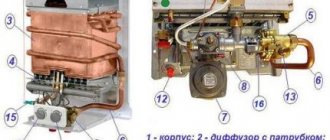Those people who are faced with issues of supplying gas to their home have to deal with various difficulties and obstacles from the gas service. The most important thing is that the legislation does not collect all the norms and requirements for equipping a boiler room in a private building in a separate document. Therefore, the country's gas producers can manipulate the requirements at their discretion, paying attention to some details and reducing their vigilance in other cases. But the basic requirements of gas workers in different regions are still largely similar. The requirements for a gas boiler room are aimed at complying with safety regulations for working with gas-powered heating appliances. They are aimed at minimizing losses from gas leaks and explosions.
Regulatory documents
You are unlikely to find a clear answer to the question of whether it is possible to install a gas unit in a bathroom in the documentation. According to SNiP standards of 1987, the placement of such equipment in the bathroom is prohibited. However, later, since 2003, the cited SNiP was declared invalid and instead SNiP 42-01-2002 “Gas distribution systems” was put into effect. But it does not clearly indicate whether a gas boiler can be installed in a bathroom. You can only get an affirmative answer by contacting your gas supply company.
Important! Only a device with a closed, hinged combustion chamber can be installed in a bathroom or toilet.
As practice shows, most gas workers prohibit the installation of gas equipment in the bathroom. The main reasons for refusal are the following:
- requirements of old standards;
- insufficient room size;
- high humidity in the bathroom, which leads to rapid failure of equipment;
- interruption of traction due to mixing of moisture with combustion products.
It’s easier for those who already had a gas boiler in their bathroom or toilet. Then they replace the old unit with a new one without much paperwork.
However, some owners resort to tricks and, in order to obtain permission from the gas service, pass off the future bathroom as a furnace room. And after installing the unit, a shower and sink are also placed there. But such a violation is fraught with negative consequences in the form of fines and disconnection from the gas main. The fact is that gas workers are required to periodically check the gas equipment located in the house, so in a year or two the fraud will still be discovered and you will have to pay dearly for it.
If, despite the refusal, you are ready to continue to seek permission to install the unit in the bathroom, then you can go the following way:
- You need to submit a request to the head of the gas service to connect a heating device in the bathroom. In this case, you should attach a list of regulatory documents that allow you to do this.
- If you are refused, you can file a claim in court, where you can always win the case.
Find out here which gas boiler is best for heating - selection criteria and manufacturers
Types of equipment
There are two types of boilers:
- storage water heater;
- flow boiler.
Storage type equipment is a boiler that is similar to a boiler. The device is equipped with a reservoir of various capacities. Storage elements are placed inside the tank. As hot water is consumed from the tank, the tank is filled with tap water. The automatic control panel allows you to regulate the heating temperature, prevents overheating and boiling of the liquid in the tank. Such boilers are produced in two modifications:
- hanging - they are mounted on the wall;
- stationary - installed on the floor.
A flow-through boiler has a more complex design. The column heats up quickly thanks to the heat exchanger. The liquid will become hot in 7-10 minutes. The main advantages of flow-through boilers:
- efficiency;
- ease of operation;
- reliability of the unit.
In addition, such devices have an automatic ignition system. This guarantees the safety of using the equipment - gas vapors are burned in full.
As practice shows, flow-type boilers are more popular. The device has small parameters, it is convenient to place it in small rooms. At the same time, the boiler’s power is enough for a family of 5 people.
Pros and cons of installing a gas boiler in the bathroom
Many people are attracted to installing a gas device in the bathroom for the following reasons:
- compact location;
- the unit is not “conspicuous” and does not interfere with movement;
- hot water is immediately supplied to the main water intake points - the sink and shower.
There are also disadvantages to this arrangement:
- high humidity negatively affects the metal parts of the device;
- bathrooms usually have small dimensions, so even a compact wall-mounted unit will take up quite a lot of space;
- there is a high probability that in order to meet all safety requirements, the bathroom will have to be re-equipped.
Think carefully about whether such placement of a gas boiler is suitable in your case. Perhaps the best installation option would be a kitchen or hallway.
Illegal places to install a washing machine
Washing equipment cannot be installed in living rooms, as this will require water communications. In the event of an accident, the damage will be significant and no insurance company will compensate for the damage to the neighbors, since the culprit intentionally created a dangerous situation.
Legal places for installing washing equipment are wet areas and the non-residential part of the apartment, but installing a washing machine in living rooms is an unacceptable option.
If the area is small, you need to use special models of washing machines that can be hidden in a closet or installed under the sink.
What requirements must a bathroom meet?
It is important to understand that not every bathroom is suitable for installing a gas boiler. For example, standard bathrooms in ordinary Khrushchev or 9-story buildings built in the 70s and 80s are too small and do not have sufficient ventilation. In order for it to make sense to even consider the possibility of installing a gas boiler in the bathroom, it must meet certain requirements:
- total area of at least 7.5 m²;
- the presence of a working ventilation system;
- there must be a window with an area of at least 0.25 m²;
- ceiling height not lower than 2 m;
- when the door is closed, there should be a gap of 1-2 cm between it and the floor;
- there should be nothing in front of the unit at a distance of 1 m;
- Bathroom walls must be made of non-combustible materials.
Thus, from the above requirements it is clear that apartment owners in multi-storey buildings are practically deprived of the opportunity to install a gas boiler in the bathroom. The owners of private houses have a better chance, since they can initially build a bathroom that meets all the given standards.
In the 60s, the Russian Federation adopted requirements for the installation and use of natural gas heating devices. The relevant code of practice restricts the operation of such equipment. As a rule, its installation in the bathroom is not provided. However, sometimes it is still possible to install boilers or water heaters in restrooms. This issue should be thoroughly studied.
Other publications in the section “Engineering systems for high-rise buildings. Water. Heating. Gas. Electric."
Question: In a 10-story apartment building, a metal heating riser in the hall is laid in the middle of the wall. I want to move it to the corner of the room with polypropylene pipes. The pipe protrudes 3 cm from the floor, 3/4 inch in diameter. Is it possible to cut an internal thread to install an American one under the floor?
Source
What types of heating devices are not suitable for a bathroom?
Types of equipment prohibited for installation in such premises include any gas units: water heaters, boilers, convectors. Therefore, the relevant services will most likely give a negative answer to the question of whether it is possible to install a gas boiler in the bathroom.
According to government standards and regulations, such devices are not intended for indoor use.
It is not permitted to operate water heating devices powered by gas and equipped with open combustion chambers in rooms with forced ventilation. Although heating devices require good air exchange for proper functioning, the installation of supply fans cannot be combined with such equipment. The combustion process is disrupted, combustion products accumulate and there is a risk of poisoning with harmful substances. It is permitted to install such devices only in certain cases.
As a rule, gas equipment specialists do not even agree to replace old products with newer ones.
Ceiling and walls
It is not recommended to sew up wall and ceiling surfaces in this room. Pipes and communications must always be visible. They must be available for emergency repairs if needed.
This solution will appeal to fans of loft and industrial styles, since from an aesthetic point of view it looks quite interesting. For example, walls can be left with visible brickwork and beautifully decorated with paint.
Important! Servicing such a boiler room will be much more convenient than in apartments through small hatches.
Is it possible to install a boiler in a toilet?
You cannot install gas equipment in a toilet without official permits. However, under certain conditions, you can obtain permission to install such units.
If you are wondering whether it is possible to install a gas boiler in a bathroom or toilet, you need to consider the following requirements:
- Redevelopment of the premises and changes to technical documentation. When the Gas Service does not provide registration of the relevant heating equipment, you can try to change the status of the premises. “Converting” a bathroom into a storage room or change room and submitting an appropriate application to the BTI will immediately help solve the problem. If the technical passport of a house or apartment indicates the appropriate types of premises, there will be no refusal from government agencies. However, the presence of plumbing fixtures may result in a ban on the installation of a heating boiler. If only the toilet has been installed in the room, changing the plan will not cause any difficulties.
- Connecting new gas equipment . Provided that registered heating equipment is mentioned in the design of the premises, there will be no problems with installing a new boiler. It is much easier to replace an old device with a new one if permission for similar devices is already available.
Gas service technicians in some regions of our country may agree to install certain water heating systems in sanitary facilities. These must be special devices with a closed combustion chamber. Before selecting and installing such equipment, you must consult with gas specialists.
Conclusion
When arranging your boiler room, it is best to consult with a knowledgeable gas service specialist in your region. Because, as inspectors checking the installation of heating equipment, they can find any reason to draw up an order with aggravating conditions or a fine. It is better to comply with all instructions from gas workers and similar services in advance. You can get acquainted with the opinions of your neighbors on equipping a room with a boiler, and get acquainted with information on the Internet. Then you will never pay extra money to representatives of the gas or chimney and ventilation services for servicing chimneys and other “inventions” of enterprising workers of such services. If there are no conditions for installing floor-standing boilers, it is better to install wall-mounted boilers that do not require such stringent requirements regarding the premises. However, when installing suspended structures, special conditions are imposed on the distribution pipeline system, couplings and adapters.
Source Source https://septik.guru/vannaya-komnata-i-tualet/pochemu-nelzya-ustanavlivat-gazovyj-kotel-v-vannoj-komnate-pravila-i-prichiny-zapreta.html https://101studio.ru /kotly/mozhno-li-v-kotelnoj-postavit-stiralnuyu-mashinu.html
How to understand the documentation
The situation with permission to carry out installation is somewhat complicated by confusion in the official documentation. The fact is that the adopted Codes of Norms and Rules do not provide a clear explanation of whether gas boilers are allowed in bathrooms. Many employees of the state gas service refer to regulation 2.04.08 –87. It says about the ban on connecting gas boilers in bathrooms.
However, according to the resolution of the State Construction Committee of the Russian Federation dated December 23, 2002, the above documents and norms are considered invalid.
The new requirements (document 42-01-2002) do not contain clear instructions or a strict ban on the installation of gas equipment. As a result, misunderstandings arise. Some employees of the Gas Service simply refuse to install heating gas structures, without delving into the intricacies of the adopted documents and standards.
Without paperwork and collecting a large number of various permits, you can only install a new gas boiler or water heater in place of old appliances in the bathroom. In this case, if a place for such equipment is already provided, and, therefore, there is also permission, the employee will agree to make the connection.
Ways to get around the ban
Some particularly smart home owners are trying to circumvent this ban.
Even at the design stage, a spacious kitchen is provided in which gas equipment is installed and registered. And after commissioning, plasterboard partitions are installed and plumbing fixtures are installed in the resulting room.
Of course, this is done mainly in private houses; in apartment buildings, such redevelopment is most often technically impossible.
It’s good if the gas service is full of acquaintances who will turn a blind eye to the position of the boiler during the inspection, but most likely, on their first visit they will write you a report on the unacceptable placement of equipment
But at the same time, the above reasons already seem reasonable enough not to do this. You also need to take into account that modern gas boilers have a connection to electricity, which requires increased protection against electric shock even in an ordinary room, not to mention a humid environment.
You must understand that regulatory requirements for the safety of installation of gas-using equipment are developed for the benefit, protection of health, life and property of people and they are quite justified from a technical point of view.
Some nuances of installing flow-through gas heaters in the toilet and bathroom
For owners of private cottages, there is another way to obtain official permission to install a boiler or gas heater in the bathroom. First, official documentation is drawn up when developing the project.
Install gas equipment in the part of the home where it is permitted. Then plumbing fixtures, such as a bathtub, are installed next to the fixture and a plasterboard partition is built around it. Such an improvised redevelopment, of course, cannot be called ideal. Subsequently, if the owner wants to sell the house, a number of problems may arise. Specialists from the Bureau of Technical Inventory will be able to conduct an examination only after dismantling the walls.
Officially, installation of a gas boiler is provided only for technical premises - storage rooms, change houses. If such rooms meet the requirements adopted for them, the installation of gas-fired water heaters is permitted.
High levels of humidity in the bathroom and temperature fluctuations often lead to breakdowns of gas heating appliances. Before deciding to install it, it is worth considering all the advantages and disadvantages and assessing the financial feasibility of installing such equipment. Obtaining official permission from the relevant authorities is not easy; this can be done by applying some legal tricks.
Entrance
It is most convenient to get into the boiler room through the interior door from the hall or corridor. This option will be much better than a separate entrance from the street.
The advantages of this solution are:
- You don’t have to spend money on buying a second warm door to enter. The price of the latter is higher than the cost of a regular interior door.
- When you need to get into the boiler room, you will not need to go outside. Housewives will especially appreciate this point, because wet cleaning in the boiler room is required with the same frequency as in the rest of the building.
- There is no need to expand the porch or make a canopy over the door to the boiler room. When entering from the street, you will inevitably have to spend money on the construction of such structures.
Additional installation conditions
It must be remembered that placing gas appliances in the basements of apartment buildings is prohibited. When installing, you must follow the following rules from clause 7.3.8:
- Gas units and heat generators are mounted on walls made of non-flammable or low-flammable materials .
- The installation must be carried out so that the gaps between the device and the wall are at least 3 cm .
- The finishing of walls near the heat generator must be made of fireproof materials .
- The facing coating must extend beyond the unit body by no less than 10 cm .
- For floor-standing equipment, additional fire safety measures must be taken. The floor surface where the heat generator is installed should be covered with special non-flammable materials . This area must be arranged so that it extends beyond the body of the gas appliance by at least 10 cm.
The official regulatory document on heating, ventilation devices and air conditioning 41 – 01–2003 in the section on heat supply systems provides rules for the installation and operation of gas appliances, as well as technical conditions for rooms where such equipment is connected.
In residential multi-storey buildings and various outbuildings, it is necessary to install heat generators with a sealed combustion chamber and automatic safety devices. Such devices stop the flow of gas when the power suddenly goes out, the protection circuits break down, when the burner malfunctions or when the pressure in the coolant decreases significantly. Sometimes an automatic emergency shutdown is necessary when there is poor smoke removal or other equipment malfunctions.
According to existing standards, units whose power does not exceed thirty-five kilowatts are allowed to be installed in the kitchen or hallway.
Appliances with heating output exceeding the specified norm must be installed in separate extensions. The total power of such equipment should not exceed one hundred kilowatts according to the standards.
The supply of oxygen for combustion processes must occur through the air duct. It must be placed on the street side for equipment with a sealed chamber. And for open-type heat generators, air is taken from the very room in which the installation was carried out. These requirements are listed in paragraph 6.2.4 of SNiP.
Provision 6.2.5 of this document states that the chimney must be positioned vertically. In this case, it is not allowed to reduce the cross-section of the smoke exhaust pipe. It cannot be laid in residential premises.
In the room where the heat generator with a sealed combustion chamber is located, it is necessary to equip general exchange ventilation, the calculation of which should be at least 1 exchange per hour.
When installing devices with an open combustion chamber, it is necessary to take into account the air flow for fuel combustion. The ventilation design prevents vacuum, which affects the removal of smoke from the heat generator.
Kitchen
The height of the room where the heating unit and cooking stove are installed must be at least 2.5 meters.
The room volume indicators vary within 15 cubic meters + 0.2 cubic meters, which are calculated for each kilowatt of gas boiler power, > 60 kW.
situation in the gas boiler room
requirements for a gas boiler room
The room must have sufficient ventilation. This includes the gas chimney and vents.
The kitchen should have a fairly wide window with a window opening outwards. The glazing area is three hundredths of a square per cubic meter of room volume. For a room occupying a volume of 16 cubic meters. m, windows should be 0.48 sq. meters. That is, in such a room, a window with dimensions of 0.5 m in width and 1 meter in height is acceptable (do not forget about the window opening outward).
A thin metal sheet or foil should be attached to the ceiling above the installed gas stove.
There should be a sufficient gap or additional ventilation at the bottom of the door.
The requirements for a gas boiler room located in the kitchen are not much different from the conditions in other isolated rooms of the house without a stove. Additionally, it should be taken into account that placement in a separate room provides for the separation of the boiler room from adjacent rooms by walls with the required fire resistance limit (not <0.75 hours). The total area of such a room and its volume depend on the power of the boiler and should be designed so as not to create obstacles for the comfortable, competent placement and maintenance of all equipment.











